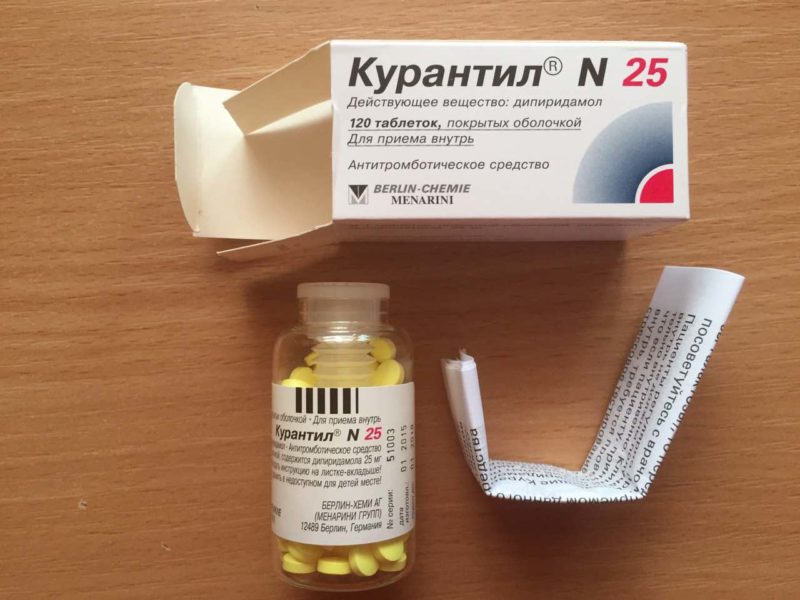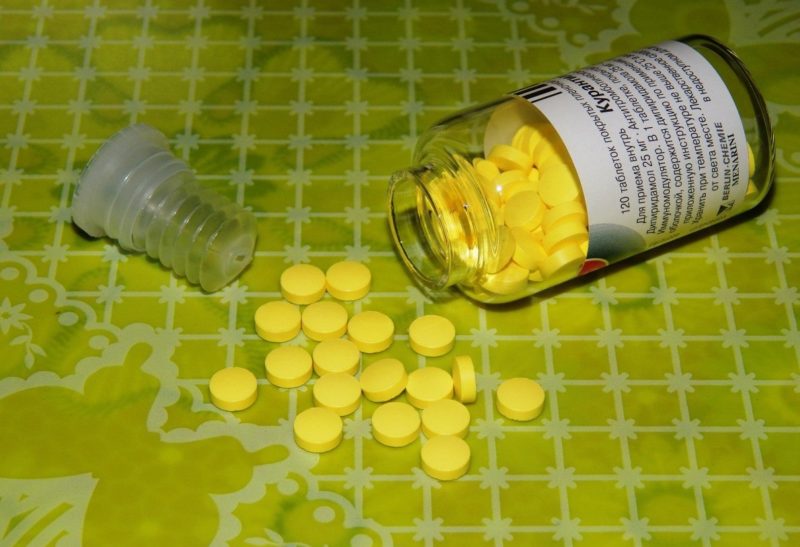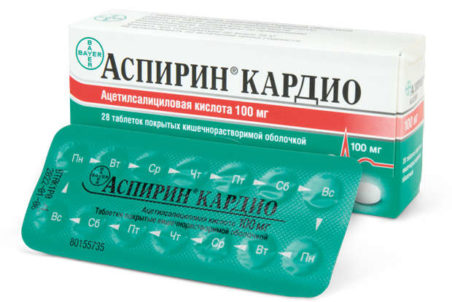The drug has beneficial effects of various kinds on the human body, and in particular - expectant mothers. Doctors often prescribe Curantil during pregnancy to prevent many complications and support the normal functioning of internal systems.
Material Content:
Description of the release form and composition
This medicine is in the form of tablets or dragees.
Each form of drug release has an active chemical compound dipyridamole in various quantities.
Quarantil dragee contains 25 mg of dipyridamole in one piece. In addition, corn starch, gelatin, magnesium stearate, glucose syrup, talcum powder are added to its composition.
A Courantil tablet may have 25 mg or 75 mg of the active compound in its composition. In addition, minor ingredients are included in this dosage form and its outer shell: highly dispersed silicon dioxide, lactose monohydrate, talc powder.
Quarantil 25 mg tablets are in a glass bottle containing 100 units of the product. Each container is placed in a pack.
Curantil 25 mg tablets are also presented in bottles made of glass. In one copy is 120 pieces.
Pharmaceutical companies enclose Curantil 75 mg tablets in blister packs of 20 each. In one cardboard package there are 2 such blisters (40 tablets).
Why is Curantil prescribed during pregnancy?
During pregnancy, the body of the expectant mother is subjected to increased stress. All internal systems operate with double power. The heart has to pump blood in huge volumes.
Chimes positively affects the circulatory system:
- prevents the formation of atherosclerotic plaques in the vessels;
- strengthens the walls of blood vessels;
- dilutes blood;
- helps to improve its circulation throughout the body.
The drug prevents the occurrence of placental insufficiency. With this pathology, the placenta ceases to function fully, namely: it ceases to supply the fetus with nutrients and oxygen. Curantyl can prevent this pathology during pregnancy by improving blood flow in the small vessels of the placenta.
The tool does not harm the child, since it acts selectively on the vessels located precisely in the placenta. Therefore, the active substance does not enter the baby's body.
In addition to normalizing the functions of the placenta, Curantil during pregnancy will help eliminate hemorrhoids, which often develops in women expecting a baby. In addition, the tool maintains normal blood pressure, which improves the functioning of other organs, in particular, the kidneys.
Dipyridamole (the active compound of Curantyl) stimulates the production of interferons. This enhances immunity, which undergoes decline during pregnancy. Thus, infection with viral infections is prevented, which can greatly harm both the expectant mother and the baby.
Other reasons for the appointment of Curantyl during pregnancy are:
- high pressure;
- cramps
- toxicosis in the last trimester of pregnancy (preeclampsia);
- swelling.
However, the appointment and selection of the dosage of the drug should be carried out by a doctor. And only after special studies of blood parameters in the laboratory.
How to take pills, dosage
According to the instructions for use of the drug, taking Curantil in tablets is required inside before meals without grinding. The drug is washed down with water or juice.
In any circumstances, whether it is the appointment of a medication when planning a pregnancy or during the gestation of a baby, the dosage of the medicine is calculated individually by the doctor.
Before determining the required amount of funds, the specialist carefully examines the patient's blood tests. Based on their results, the doctor determines whether the medication should be prescribed in a particular situation and how much medicine should be taken by a woman.
When planning a baby conception
Experts advise taking a course of taking Curantil about 3 months before the time of the alleged conception.
The maximum allowable amount of medication per day is 600 mg. However, in such doses, the drug is drunk only under the close supervision of a doctor and if there are good reasons. In standard situations, the dose of the prescribed drug is lower.
In preparation for pregnancy, Curantyl is taken according to a specially designated scheme.
These systems are designed to solve specific problems:
- Strengthening the immune system. To achieve this effect, the medication is taken 50 mg every day for a month. During therapy, changes in blood coagulation are regularly monitored and immune responses monitored.
- Stimulation of blood circulation. It is one of the most common causes of dipyridamole. Curantil in this case is prescribed according to the following scheme: 3 mg 75 times a day. Duration of admission is 3 weeks. Then a break is made for an identical period, after which treatment is resumed.
- Decreased platelet aggregation. The elimination of such a problem requires significant doses of the therapeutic compound to be taken. Chimes consume 75-225 mg every day. Sometimes the doctor prescribes the maximum permitted dose of a therapeutic agent (600 mg).
The duration of treatment is determined by the attending doctor.
In the early stages
During the first trimester of pregnancy, the decision to contact the drug compound and its dosage is made by the doctor based on the patient’s analyzes.

Usually, medication for pregnant women is as follows: 25 mg of Curantyl in 3 sets per day. If this is not enough, then the dosage of Courantil during pregnancy is increased by the doctor to 75 mg once or 2 times a day.
Drug interaction
The following features of interaction with other substances are characteristic of the drug:
- The effectiveness of the drug decreases when used together with xanthine derivatives (for example, coffee or tea).
- The effect of taking the drug is enhanced when combined with indirect anticoagulants for internal use.
- Curantyl enhances the effect of lowering blood pressure from taking antihypertensive drugs and reduces the cholinergic abilities of substances that suppress cholinesterase.
- When combined with antibacterial drugs from the group of cephalosporins, their anti-aggregation activity increases.
- Hydrochloric acid neutralizing agents used in the treatment of gastric diseases reduce the highest concentration of the drug due to a decrease in absorption.
These reactions to the combination of a medication with other drugs and substances only confirm the need for consultation with a doctor before starting the course.
Possible side effects
When taking the drug in therapeutic doses, undesirable reactions rarely occur. And if this happens, they appear in a mild form and do not last long.
Circulatory system:
- increase or decrease in heart rate;
- a feeling of heat in the face;
- blood flow disorder in the heart muscle (at doses above 225 mg per day);
- pressure drop.
Blood coagulation level:
- change in platelet cell activity;
- a decrease in the level of platelet agents in the blood serum;
- the occurrence of bleeding;
- large blood loss during operations (in extremely rare cases).
Digestive tract:
- soreness in the upper abdomen;
- feeling of nausea, vomiting;
- diarrhea.
Other reactions:
- a noise in the head or feeling as if ears were stuffy;
- Dizziness
- the occurrence of a breakdown;
- blood rushes to the face;
- headache;
- the development of inflammatory lesions in the joints;
- inflammation of the nasal mucosa;
- muscle pain
- rash of allergic origin.
With prolonged therapy, adverse effects in the digestive system usually go away on their own.
Contraindications and overdose
Taking a medication is contraindicated in such conditions:
- acute phase of myocardial infarction;
- atherosclerotic lesions of the coronary arteries;
- acute vascular insufficiency;
- decompensated heart failure;
- hypertrophic obstructive cardiomyopathy;
- low blood pressure;
- serious heart rhythm abnormalities;
- complicated hypertension;
- obstructive chronic pathologies of the bronchi and lungs;
- dangerous diseases of the kidneys and liver;
- disorders with the risk of hemorrhage and bleeding;
- conditions when there is a high probability of bleeding;
- intolerance or hypersensitivity to the ingredients of a medical product;
- for the age category under 12 years old;
With an overdose of the drug, angina attacks, palpitations, a drop in pressure, loss of strength, a feeling of heat and dizziness occur.
If you suspect an excess dose, it is important to rather stimulate vomiting to cleanse the stomach and take sorbent preparations.
To compensate for the vasodilating effect, aminophylline is administered intravenously (50-100 mg per minute).
If the phenomena of angina pectoris are not eliminated, then nitroglycerin must be taken under the tongue.
Analogs of Curantila
There are a fairly large number of drugs that have anticoagulant and antiplatelet effects that can replace Curantyl.
The most common are:
• Aspirin cardio;
• Aterocardium;
• Zilt;
• Aspicore;
• Godasal;
• Aspecard;
• Cardiomagnyl;
• Atrogrel;
• clopidogrel;
• Brilinta;
• Plagril;
• Disgren;
• Magnikor;
• Plavix;
• Trombone and other means.
Replacing the drug with its analogues can only be done by the attending doctor.
Curantyl improves blood circulation, stimulates the immune system and reduces the likelihood of thrombosis. Therefore, his competent admission is of great benefit both for a pregnant woman, and for her unborn child.






















